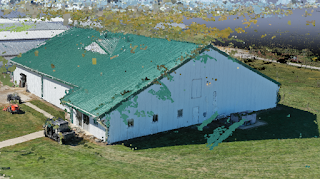This week involved more advanced features in Multi-patch and the beginning of the creation of everything we will use for GIS Day at Purdue. We collected more data at the Purdue Beef Unit, this data is non-rectangular so it will challenge the Multi-patch software and our team to see if creation of these models are still easier than the standard 3D modeling. For GIS day, where numerous industry professionals will come to Purdue to look at the work that researchers are putting in, we started creating a poster portraying what Multi-patch can do.
Adept Skills in Multi-patch:
At the Purdue Beef Unit, we focused on non-rectangular and buildings with convex roofs. This will allow us to work increasing our skills in Multi-patch creation and to analyze if these intermediate buildings are still done easier versus doing them in a basic 3D model in PIX4D
 |
| Convex Roofs in Multi-patch |
| The roof was very easy to separate and pull up the convex sections, but our one failure of the data collection was that we did not gather the dimensions yet, so the convex roof points were done on a freehand basis. |
 |
| Convex Roofs in Pix4D |
The timing of the collection and the processing still points to Multi-patch being superior. Below is a breakdown of the timing.
GIS Day Poster Template:
The main things that we tried to focus on for this template creation were based off of how the human eye will normally interpret things. Western language speakers will naturally read left to right, then top to bottom. Using that information, we put our research question and abstract first, so immediately the main point would be read. Right under that we put our comparison of each of the software packages, this puts all vital information nearby. On the right of that section, Multi-patch and PIX4D analysis are listed. Again, since the human eye reads top to bottom, the Pros of Multi-patch will be seen first and interpreted as superior. Below that section are the section for importing and exporting from Multi-patch. This is listed as importing on the left and exporting on the right to flow easily with the reader. More work will take place as time goes on, but this is the start of presenting our data.
Class Poster Creation:
Our class was assigned to create a poster to be placed in the hallway of the Purdue Niswonger Building. We were allowed to create the poster using any topic and focusing on any audience of our choosing. Once we decided that our audience would be parents, prospective students, and current students, we decided that the topic should show off why Unmanned Aerial Systems is an upcoming and relevant field. Because of this, we were able to use data collected from our capstone project with 3D modeling along with a focus on High Resolution Imagery, GIS Data, and Search and Rescue.
 |
My Contribution:
For the design of our new class poster I was vetted and selected as project manager, in charge of the entire Unmanned Areal Systems capstone department. I was less of the small hands on stuff and was tasked with designing, finalizing, and printing. Keeping everyone on task was quite easy, because I just let them know that the sooner we get this done the sooner we could leave for lunch! We broke off into two groups, one to go take the fleet picture, and one to build the actual poster. The overall construction of the poster went smoothly once we decided on the poster outline it was smooth sailing.
For the design of our new class poster I was vetted and selected as project manager, in charge of the entire Unmanned Areal Systems capstone department. I was less of the small hands on stuff and was tasked with designing, finalizing, and printing. Keeping everyone on task was quite easy, because I just let them know that the sooner we get this done the sooner we could leave for lunch! We broke off into two groups, one to go take the fleet picture, and one to build the actual poster. The overall construction of the poster went smoothly once we decided on the poster outline it was smooth sailing.



No comments:
Post a Comment